Time Prediction Models for Echinococcosis Based on Gray System Theory and Epidemic Dynamics
Abstract
:1. Introduction
2. Materials and Methods
2.1. Short-Term Prediction Models
2.1.1. Original GM(1,1) Model
2.1.2. Grey-Periodic Extensional Combinatorial Model (PECGM(1,1))
2.1.3. Modified Grey Model Using Fourier Series (FGM(1,1))
2.1.4. The ARIMA Model
2.1.5. Model Accuracy Examination
2.2. Long-Term Prediction Model
3. Results
3.1. Short-Term Prediction Results
3.2. Long-Term Prediction Results
3.2.1. Fitting Results
3.2.2. Sensitivity Analysis
4. Conclusions
Supplementary Materials
Acknowledgments
Author Contributions
Conflicts of Interest
References
- Wang, K.; Zhang, X.; Jin, Z.; Ma, H.; Teng, Z.; Wang, L. Modeling and analysis of the transmission of Echinococcosis with application to Xinjiang Uygur Autonomous Region of China. J. Theor. Biol. 2013, 333, 78–90. [Google Scholar] [CrossRef] [PubMed]
- Budke, C.M.; Deplazes, P.; Torgerson, P.R. Global socioeconomic impact of cystic Echinococcosis. Emerg. Infect. Dis. 2006, 12, 296–303. [Google Scholar] [CrossRef] [PubMed]
- Craig, P.S.; McManus, D.P.; Lightowlers, M.W.; Chabalgoity, J.A.; Garcia, H.H.; Gavidia, C.M.; Gilman, R.H.; Gonzalez, A.E.; Lorca, M.; Naquira, C.; et al. Prevention and control of cystic echinococcosis. Lancet Infect. Dis. 2007, 7, 385–394. [Google Scholar] [CrossRef]
- Eckert, J.; Deplazes, P. Biological, epidemiological, and clinical aspects of echinococcosis, a zoonosis of increasing concern. Clin. Microbiol. Rev. 2004, 17, 107–135. [Google Scholar] [CrossRef] [PubMed]
- Eckert, J.; Deplazes, P.; Craig, P.; Gemmell, M.A.; Gottstein, B.; Heath, D.; Lightowlers, M. Echinococcosis in animals: Clinical aspects, diagnosis and treatment. In WHO/OIE Manual on Echinococcosis in Humans and Animals: A Public Health Problem of Global Concern, 1st ed.; Eckert, J., Gemmell, M.A., Meslin, F.X., Pawłowski, Z.S., Eds.; World Organisation for Animal Health (Office International des Epizooties) and World Health Organization: Paris, France, 2001; pp. 73–99. [Google Scholar]
- Moro, P.; Schantz, P.M. Echinococcosis: A review. J. Infect. Dis. 2009, 13, 125–133. [Google Scholar] [CrossRef] [PubMed]
- Pawlowski, Z.S.; Eckert, J.; Vuitton, D.A.; Ammann, R.W.; Kern, P.; Craig, P.S.; Grimm, F. Echinococcosis in humans: Clinical aspects, diagnosis and treatment. In WHO/OIE Manual on Echinococcosis in Humans and Animals: A Public Health Problem of Global Concern, 1st ed.; Eckert, J., Gemmell, M.A., Meslin, F.X., Pawłowski, Z.S., Eds.; World Organisation for Animal Health (Office International des Epizooties) and World Health Organization: Paris, France, 2001; pp. 20–71. [Google Scholar]
- Box, G.E.; Jenkins, G.M.; Reinsel, G.C.; Ljung, G.M. Time Series Analysis: Forecasting and Control, 4th ed.; John Wiley & Sons, Inc.: Hoboken, NJ, USA, 2015; pp. 1–727. [Google Scholar]
- Deng, J. Control problems of grey systems. Syst. Control Lett. 1982, 1, 288–294. [Google Scholar]
- Yin, M.S. Fifteen years of grey system theory research: A historical review and bibliometric analysis. Expert Syst. Appl. 2013, 40, 2767–2775. [Google Scholar] [CrossRef]
- Lin, C.S.; Liou, F.M.; Huang, C.P. Grey forecasting model for CO2 emissions: A Taiwan study. Appl. Energy 2011, 88, 3816–3820. [Google Scholar] [CrossRef]
- Lei, M.; Feng, Z. A proposed grey model for short-term electricity price forecasting in competitive power markets. Int. J. Electr. Power 2012, 43, 531–538. [Google Scholar] [CrossRef]
- Peng, Y.; Dong, M. A hybrid approach of HMM and grey model for age-dependent health prediction of engineering assets. Expert Syst. Appl. 2011, 38, 12946–12953. [Google Scholar] [CrossRef]
- Huang, K.Y.; Jane, C.J. A hybrid model for stock market forecasting and portfolio selection based on ARX, grey system and RS theories. Expert Syst. Appl. 2009, 36, 5387–5392. [Google Scholar] [CrossRef]
- Ma, Z.; Zhou, Y.; Wu, J. Modeling and Dynamics of Infectious Diseases, 1st ed.; World Scientific Publishing Company: Singapore, 2009; pp. 1–341. [Google Scholar]
- Cui, J.; Liu, S.F.; Zeng, B.; Xie, N.M. A novel grey forecasting model and its optimization. Appl. Math. Model. 2013, 37, 4399–4406. [Google Scholar] [CrossRef]
- Hsu, C.C.; Chen, C.Y. Applications of improved grey prediction model for power demand forecasting. Energy Convers. Manag. 2003, 44, 2241–2249. [Google Scholar] [CrossRef]
- Lin, Y.H.; Lee, P.C.; Chang, T.P. Adaptive and high-precision grey forecasting model. Expert Syst. Appl. 2009, 36, 9658–9662. [Google Scholar] [CrossRef]
- Xie, N.M.; Liu, S.F. Discrete grey forecasting model and its optimization. Appl. Math. Model. 2009, 33, 1173–1186. [Google Scholar] [CrossRef]
- Chen, C.I.; Huang, S.J. The necessary and sufficient condition for GM(1,1) grey prediction model. Appl. Math. Comput. 2013, 219, 6152–6162. [Google Scholar] [CrossRef]
- Kumar, U.; Jain, V.K. Time series models (Grey-Markov, Grey Model with rolling mechanism and singular spectrum analysis) to forecast energy consumption in India. Energy 2010, 35, 1709–1716. [Google Scholar] [CrossRef]
- Lee, Y.S.; Tong, L.I. Forecasting nonlinear time series of energy consumption using a hybrid dynamic model. Appl. Energy 2012, 94, 251–256. [Google Scholar] [CrossRef]
- Tien, T.L. The deterministic grey dynamic model with convolution integral DGDMC(1,n). Appl. Math. Model. 2009, 33, 3498–3510. [Google Scholar] [CrossRef]
- Tseng, F.M.; Yu, H.C.; Tzeng, G.H. Applied hybrid grey model to forecast seasonal time series. Technol. Forecast. Soc. 2001, 67, 291–302. [Google Scholar] [CrossRef]
- Wang, Y.F. Predicting stock price using fuzzy grey prediction system. Expert Syst. Appl. 2002, 22, 33–38. [Google Scholar] [CrossRef]
- Zhou, Z.J.; Hu, C.H. An effective hybrid approach based on grey and ARMA for forecasting gyro drift. Chaos Soliton Fract. 2008, 35, 525–529. [Google Scholar] [CrossRef]
- Yao, A.W.; Chi, S.C.; Chen, C.K. Development of an integrated Grey–fuzzy-based electricity management system for enterprises. Energy 2005, 30, 2759–2771. [Google Scholar] [CrossRef]
- Kayacan, E.; Ulutas, B.; Kaynak, O. Grey system theory-based models in time series prediction. Expert Syst. Appl. 2010, 37, 1784–1789. [Google Scholar] [CrossRef]
- Yang, L.; Bi, Z.W.; Kou, Z.Q.; Li, X.J.; Zhang, M.; Wang, M.; Zhang, L.Y.; Zhao, Z.T. Time-series analysis on human brucellosis during 2004–2013 in Shandong province, China. Zoonoses Public Health 2015, 62, 228–235. [Google Scholar] [CrossRef] [PubMed]
- Chadsuthi, S.; Modchang, C.; Lenbury, Y.; Iamsirithaworn, S.; Triampo, W. Modeling seasonal leptospirosis transmission and its association with rainfall and temperature in Thailand using time-series and ARIMAX analyses. Asian Pac. J. Trop. Med. 2012, 5, 539–546. [Google Scholar] [CrossRef]
- Wang, T.; Liu, J.; Zhou, Y.; Cui, F.; Huang, Z.; Wang, L.; Zhai, S. Prevalence of hemorrhagic fever with renal syndrome in Yiyuan county, China, 2005–2014. BMC Infect. Dis. 2016, 16, 69. [Google Scholar] [CrossRef] [PubMed]
- Zhang, X.; Zhang, T.; Pei, J.; Liu, Y.; Li, X.; Medrano-Gracia, P. Time series modelling of syphilis in China from 2005 to 2012. PLoS ONE 2016, 11, e0149401. [Google Scholar] [CrossRef] [PubMed]
- Chinese Bureau of National Statistics. China Statistical Yearbook 2015, 1st ed.National Bureau of Statistics of China: Beijing, China, 2015.
- Zhang, T.; Wang, K.; Zhang, X. Modeling and analyzing the transmission dynamics of HBV epidemic in Xinjiang, China. PLoS ONE 2015, 10, e0138765. [Google Scholar] [CrossRef] [PubMed]
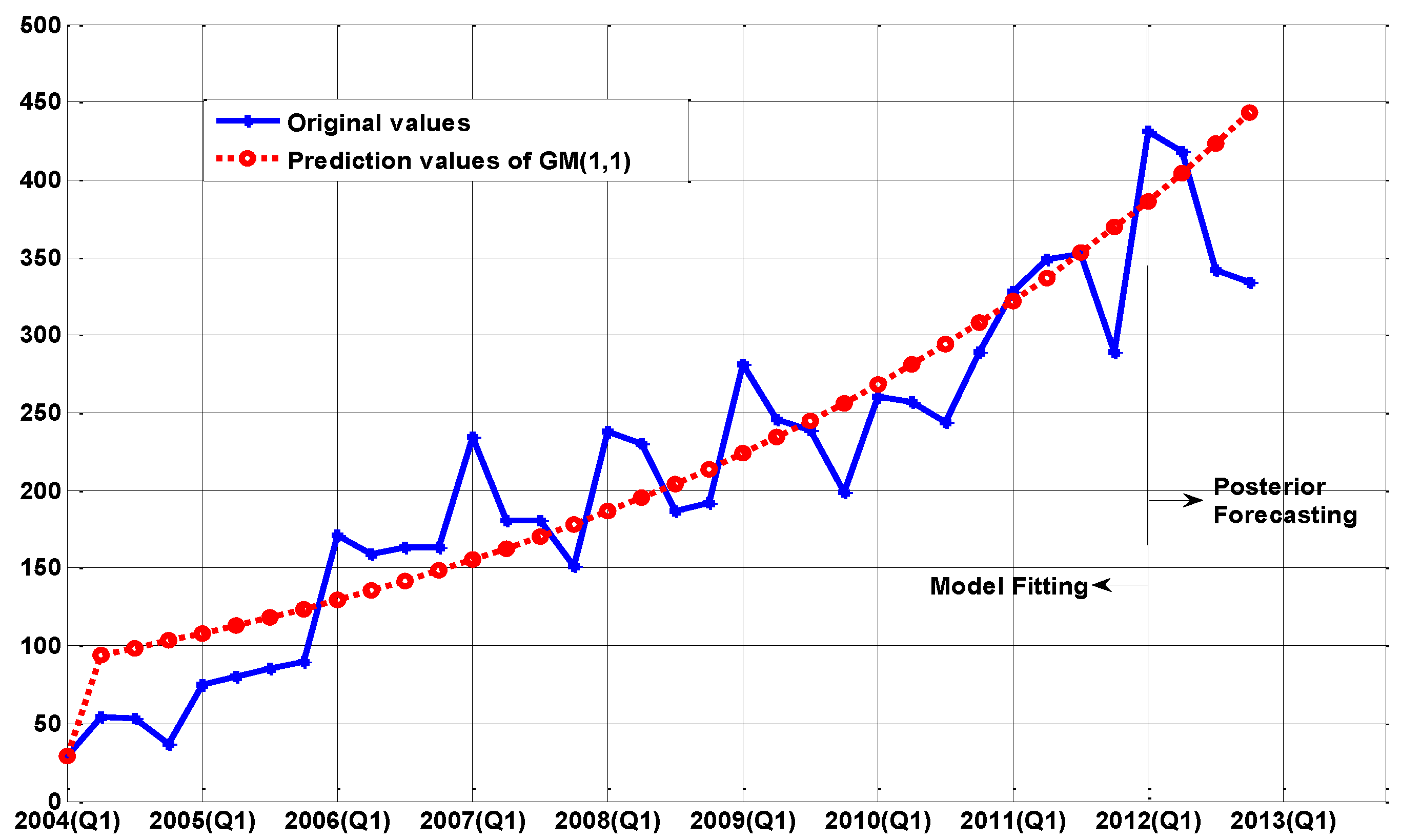
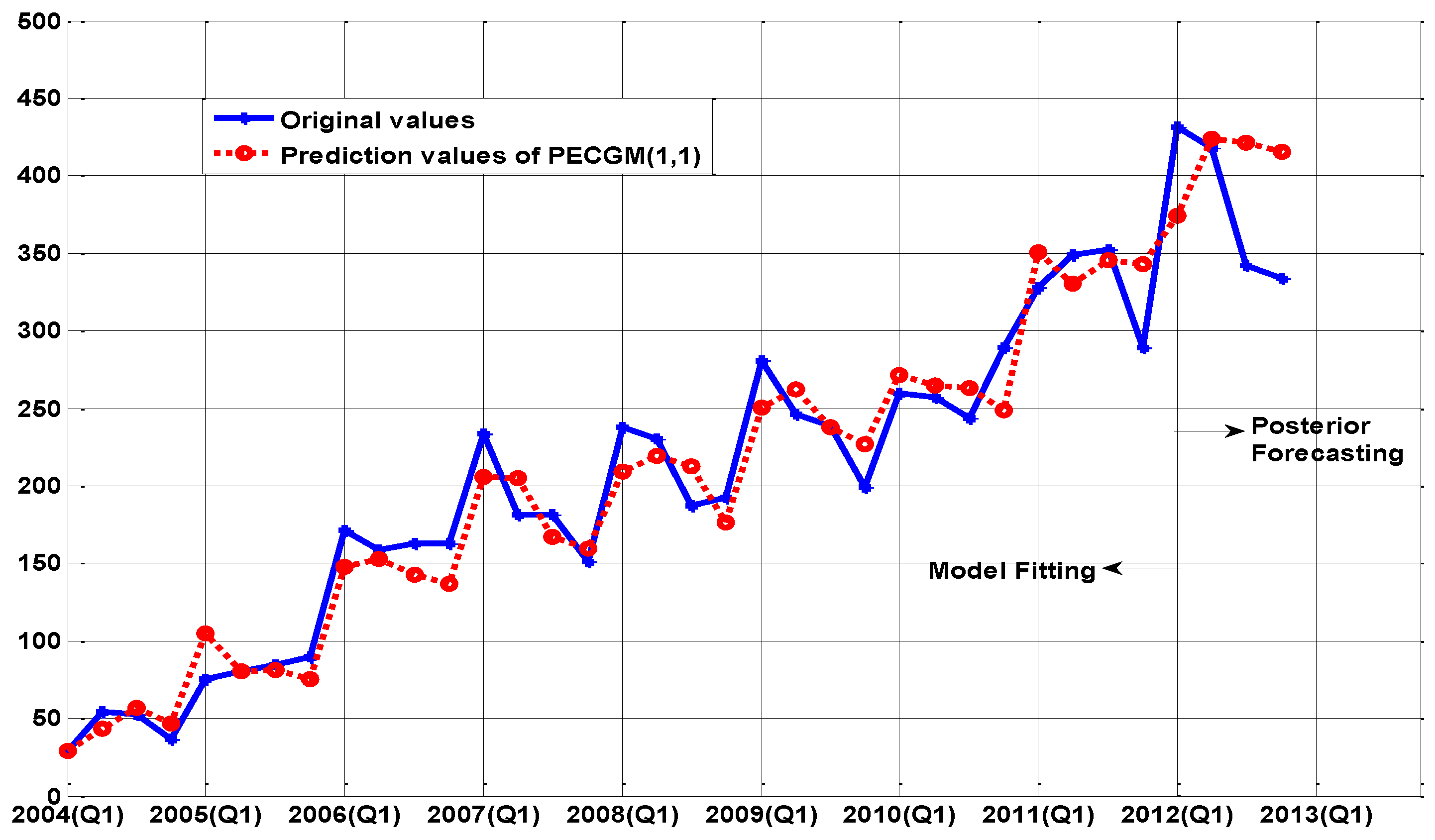

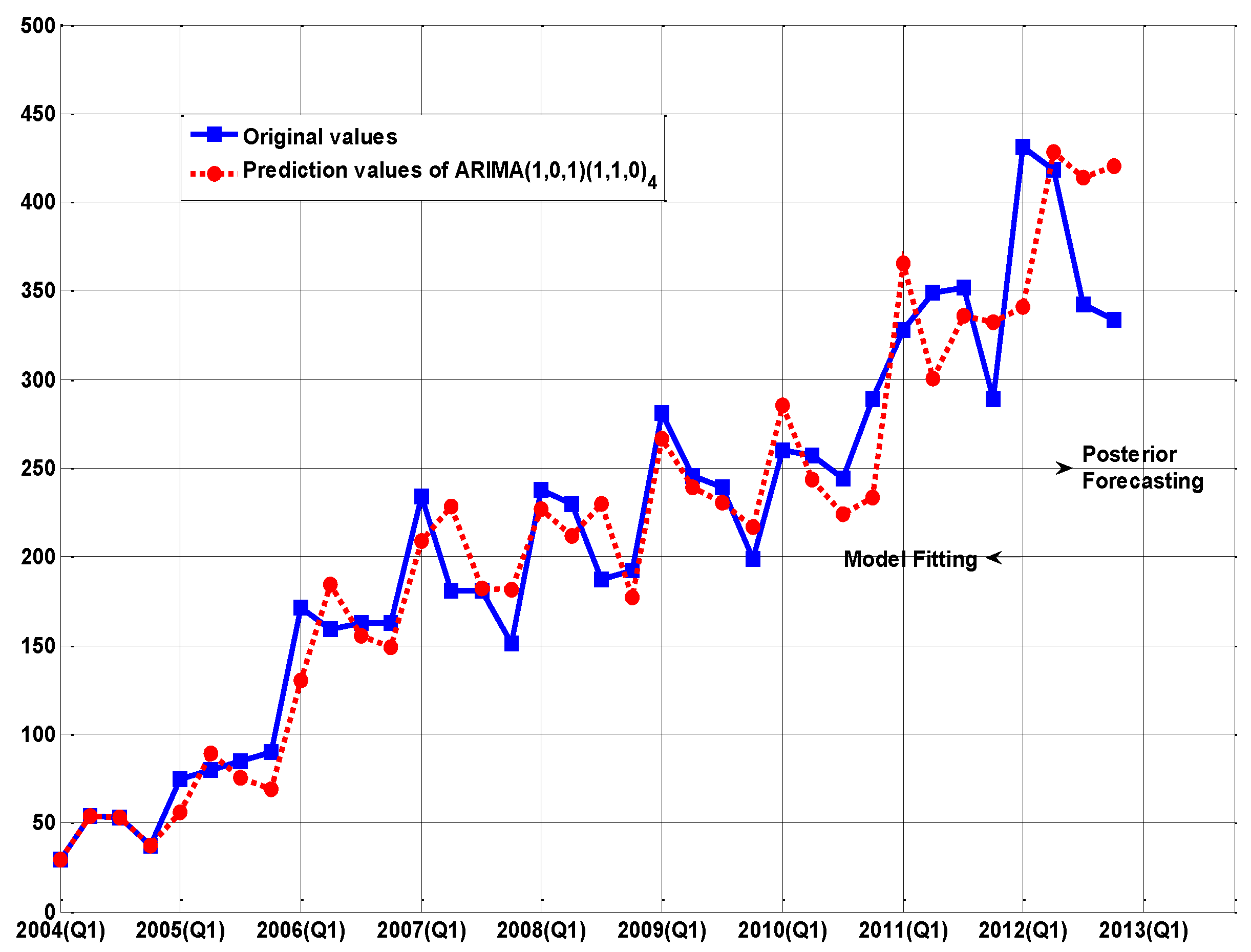
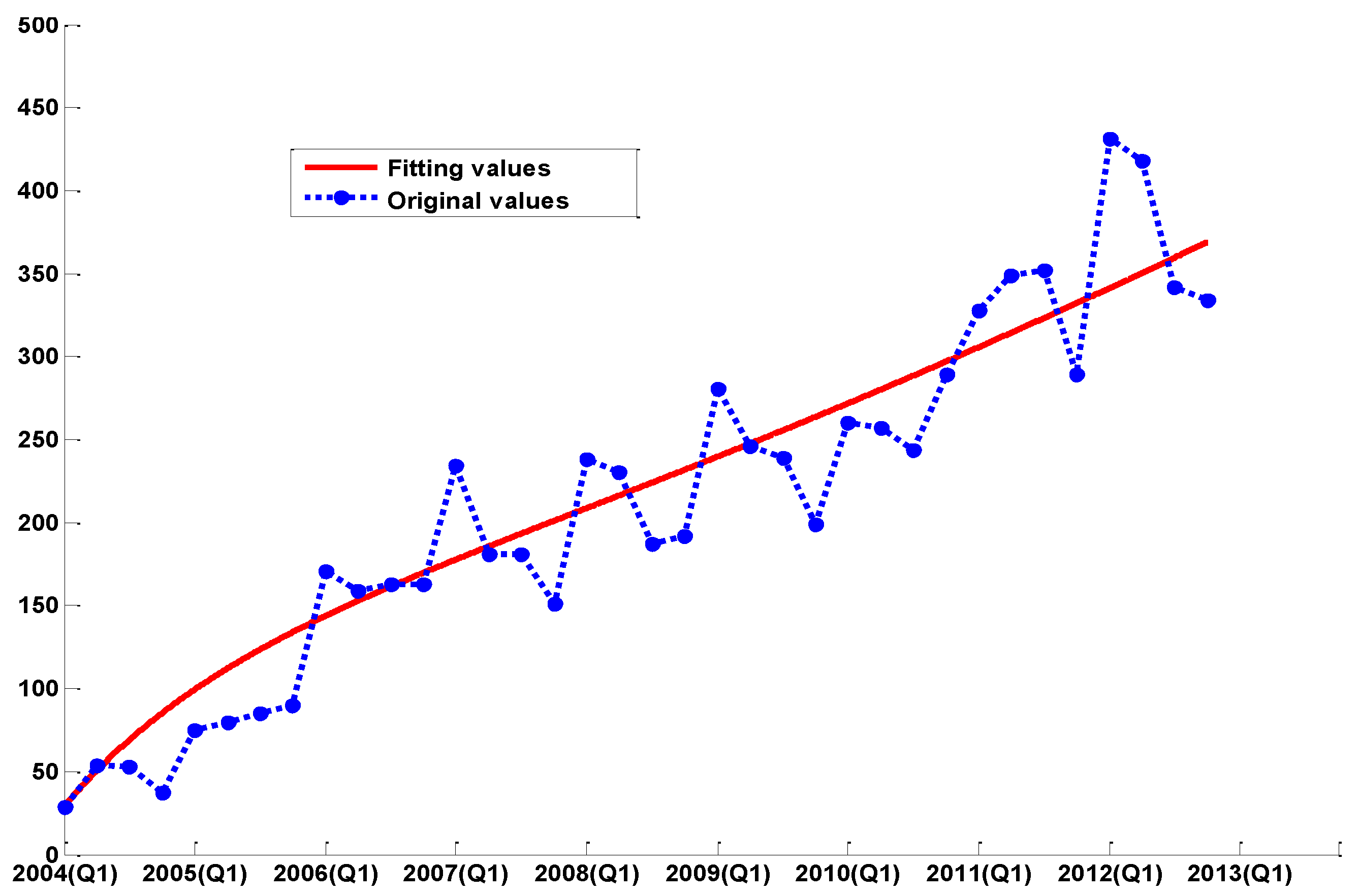
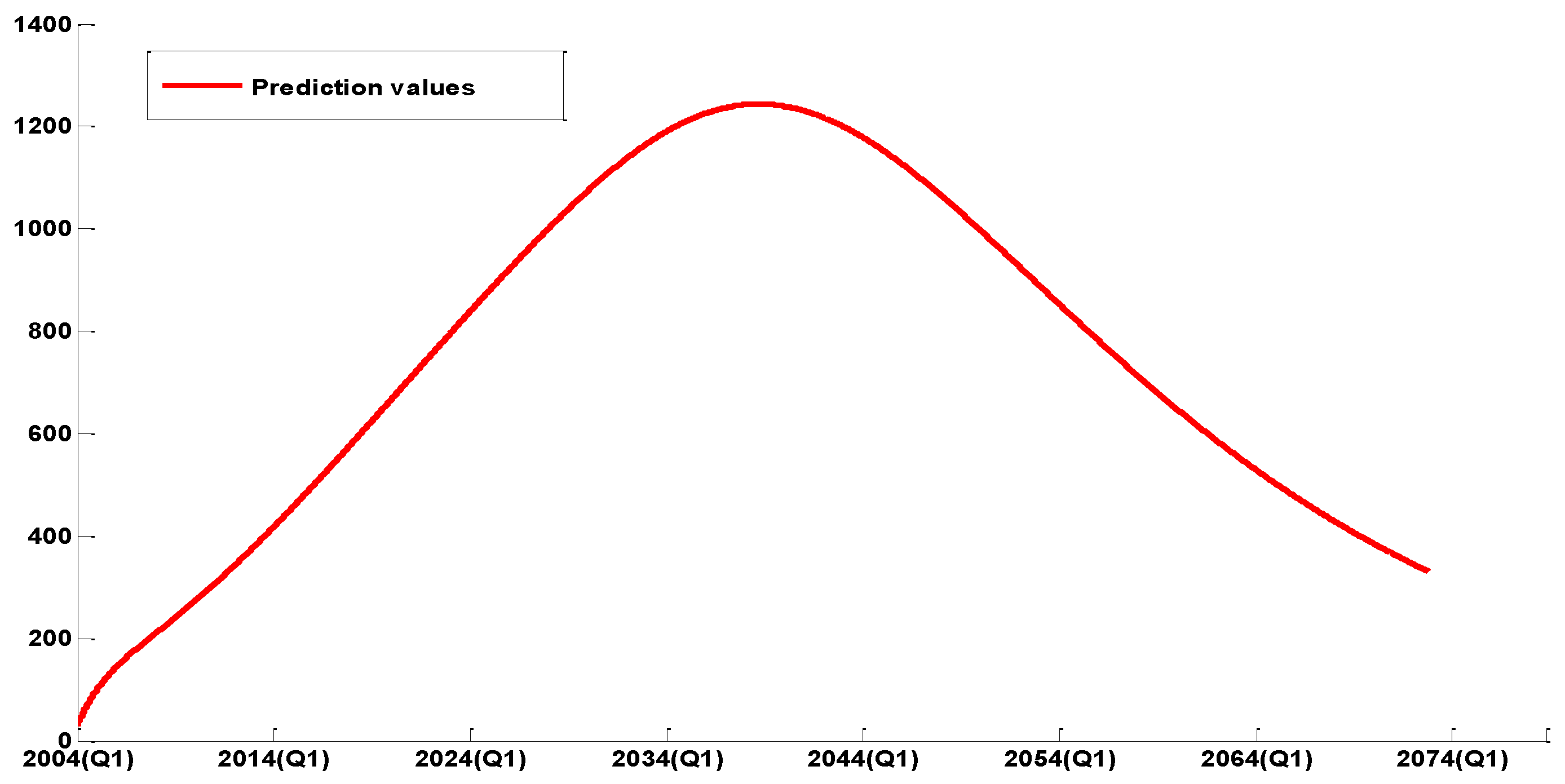
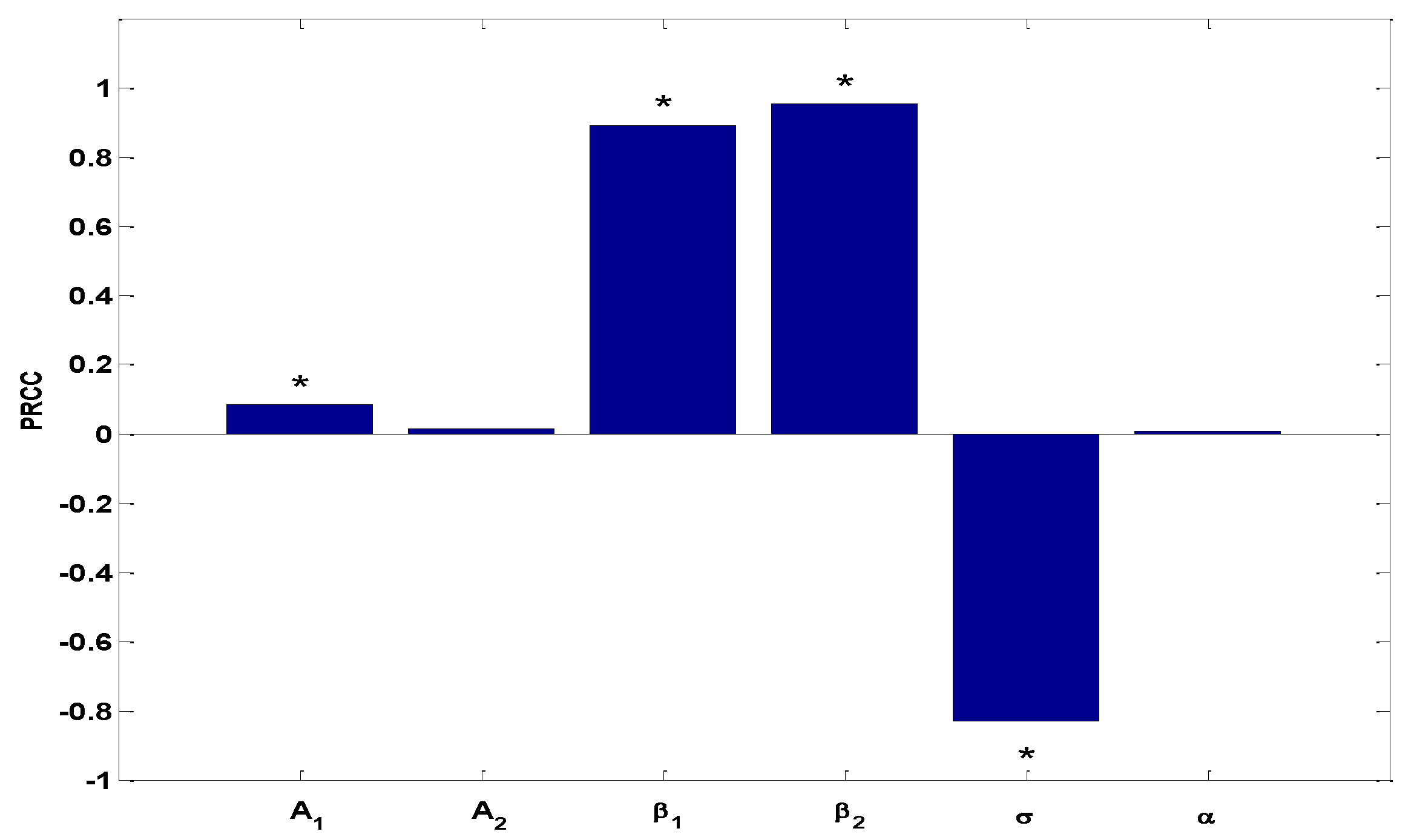
| Time | Original Values | GM(1,1) | PECGM(1,1) | FGM(1,1) | ARIMA(1,0,1)(1,1,0)4 |
|---|---|---|---|---|---|
| 2004-Q1 | 29 | ||||
| 2004-Q2 | 54 | 94.1602 | 43.2064 | 66.6371 | 53.9460 |
| 2004-Q3 | 53 | 98.5481 | 56.6699 | 40.3629 | 52.9470 |
| 2004-Q4 | 37 | 103.1405 | 46.8164 | 49.6371 | 36.9630 |
| 2005-Q1 | 75 | 107.947 | 104.9348 | 62.3629 | 56.0506 |
| 2005-Q2 | 80 | 112.9774 | 80.6936 | 92.6371 | 88.8068 |
| 2005-Q3 | 85 | 118.2423 | 81.1441 | 72.3629 | 75.6675 |
| 2005-Q4 | 90 | 123.7525 | 75.6184 | 102.6371 | 68.5544 |
| 2006-Q1 | 171 | 129.5195 | 148.0873 | 158.3629 | 130.5286 |
| 2006-Q2 | 159 | 135.5552 | 152.8614 | 171.6371 | 184.2488 |
| 2006-Q3 | 163 | 141.8722 | 142.374 | 150.3629 | 155.4327 |
| 2006-Q4 | 163 | 148.4836 | 136.5795 | 175.6371 | 148.7839 |
| 2007-Q1 | 234 | 155.403 | 206.1309 | 221.3629 | 208.9408 |
| 2007-Q2 | 181 | 162.645 | 204.6812 | 193.6371 | 228.0572 |
| 2007-Q3 | 181 | 170.2244 | 167.3362 | 168.3629 | 182.2278 |
| 2007-Q4 | 151 | 178.157 | 159.3529 | 163.6371 | 181.2402 |
| 2008-Q1 | 238 | 186.4593 | 209.4171 | 225.3629 | 227.2463 |
| 2008-Q2 | 230 | 195.1485 | 219.1547 | 242.6371 | 211.5525 |
| 2008-Q3 | 187 | 204.2426 | 212.3443 | 174.3629 | 229.9090 |
| 2008-Q4 | 192 | 213.7605 | 176.2863 | 204.6371 | 177.1743 |
| 2009-Q1 | 281 | 223.7219 | 250.2797 | 268.3629 | 266.3309 |
| 2009-Q2 | 246 | 234.1475 | 261.9837 | 258.6371 | 239.4284 |
| 2009-Q3 | 239 | 245.059 | 237.8308 | 226.3629 | 230.8546 |
| 2009-Q4 | 199 | 256.479 | 226.4649 | 211.6371 | 216.9646 |
| 2010-Q1 | 260 | 268.4312 | 271.189 | 247.3629 | 284.9956 |
| 2010-Q2 | 257 | 280.9403 | 264.9865 | 269.6371 | 243.4996 |
| 2010-Q3 | 244 | 294.0324 | 262.9642 | 231.3629 | 223.7910 |
| 2010-Q4 | 289 | 307.7346 | 248.4205 | 301.6371 | 233.6549 |
| 2011-Q1 | 328 | 322.0753 | 350.6532 | 315.3629 | 365.3474 |
| 2011-Q2 | 349 | 337.0843 | 330.7005 | 361.6371 | 300.1962 |
| 2011-Q3 | 352 | 352.7928 | 345.6146 | 339.3629 | 335.7246 |
| 2011-Q4 | 289 | 369.2333 | 342.7292 | 301.6371 | 332.4649 |
| 2012-Q1 | 431 | 386.4399 | 374.0377 | 418.3629 | 340.5767 |
| MAD | 31.9641 | 19.2301 | 12.6371 | 22.9506 | |
| MAPE (%) | 25.0438 | 10.4278 | 8.6256 | 11.7100 | |
| RMSE | 37.448 | 23.1066 | 12.4442 | 30.2869 | |
| 2012-Q2 | 418 | 404.4483 | 423.8045 | 376.9253 | 428.4281 |
| 2012-Q3 | 342 | 423.296 | 421.0678 | 365.1108 | 413.7626 |
| 2012-Q4 | 334 | 443.02 | 415.5579 | 389.5186 | 420.2279 |
| MAD | 67.96 | 47.3842 | 28.1548 | 56.1395 | |
| MAPE (%) | 19.8847 | 16.3088 | 11.0688 | 16.4300 | |
| RMSE | 78.906 | 65.6686 | 42.0458 | 65.0483 |
| Parameters | Value | Comments |
|---|---|---|
| annual crop of newborn puppies | ||
| dog natural mortality rate | ||
| livestock to dog transmission rate | ||
| 0.5 | rate moving from infected to non-infected dog | |
| annual crop of newborn livestock | ||
| livestock mortality rate | ||
| parasite egg-to-livestock transmission rate | ||
| 1.65 | released rate from infected dog | |
| 47.5 | parasite egg mortality rate | |
| human annual birth population | ||
| human natural mortality rate | ||
| human incubation period | ||
| human disease-related death rate | ||
| 0.1875 | treatment/recovery rate | |
| parasite egg-to-human transmission rate |
| Input Parameter | The Basic Production Number | |
|---|---|---|
| PRCC | Value | |
| 0.0833 | 0.0000 | |
| 0.0148 | 0.4183 | |
| 0.8916 | 0.0000 | |
| 0.9530 | 0.0000 | |
| −0.8307 | 0.0000 | |
| 0.0071 | 0.6964 | |
© 2017 by the authors. Licensee MDPI, Basel, Switzerland. This article is an open access article distributed under the terms and conditions of the Creative Commons Attribution (CC BY) license ( http://creativecommons.org/licenses/by/4.0/).
Share and Cite
Zhang, L.; Wang, L.; Zheng, Y.; Wang, K.; Zhang, X.; Zheng, Y. Time Prediction Models for Echinococcosis Based on Gray System Theory and Epidemic Dynamics. Int. J. Environ. Res. Public Health 2017, 14, 262. https://doi.org/10.3390/ijerph14030262
Zhang L, Wang L, Zheng Y, Wang K, Zhang X, Zheng Y. Time Prediction Models for Echinococcosis Based on Gray System Theory and Epidemic Dynamics. International Journal of Environmental Research and Public Health. 2017; 14(3):262. https://doi.org/10.3390/ijerph14030262
Chicago/Turabian StyleZhang, Liping, Li Wang, Yanling Zheng, Kai Wang, Xueliang Zhang, and Yujian Zheng. 2017. "Time Prediction Models for Echinococcosis Based on Gray System Theory and Epidemic Dynamics" International Journal of Environmental Research and Public Health 14, no. 3: 262. https://doi.org/10.3390/ijerph14030262






